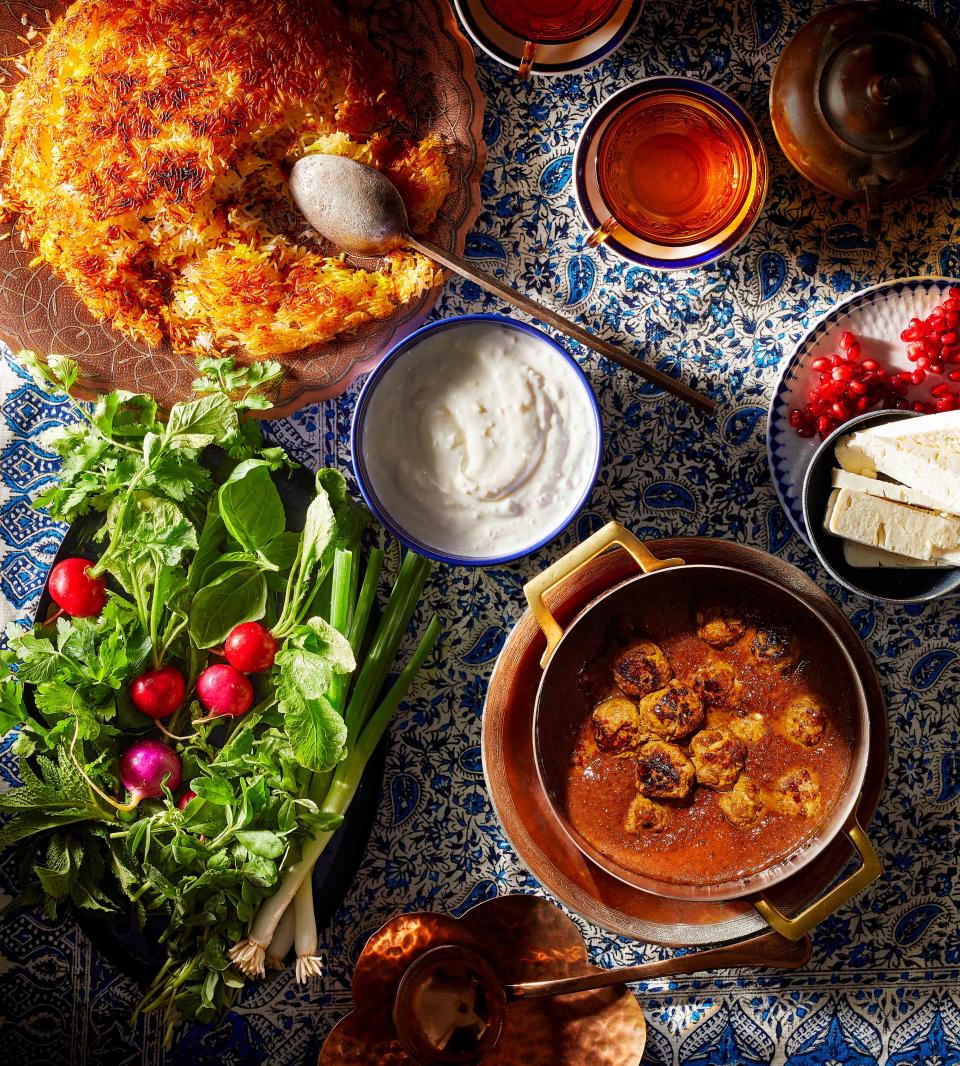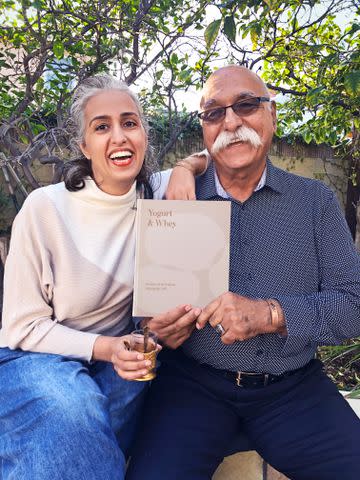Cookbook Author Homa Dashtaki Shares Her Iranian Heritage One Yogurt at a Time
In her new cookbook, Yogurt & Whey, Homa Dashtaki—founder of The White Moustache yogurt company—shares nostalgic family recipes from her Iranian heritage.

Carson Downing. Food Styling: Kelsey Moylan
Each glass jar from The White Moustache contains a few precious ounces of traditionally fermented yogurt. Some feature sour cherries, dates, or orange blossom honey at the bottom, but the velvety yogurt—which takes Homa Dashtaki and her team three days to make—is the star. Compared to big brands, hers is a charmingly artisan process. She makes 15 batches of naturally-fermented yogurt weekly and has a list of stores waiting to carry it.
Besides yogurt, The White Moustache now also offers labneh (a thick, spreadable type of yogurt cheese) and probiotic tonics and pops made with whey, the tangy, probiotic liquid gold produced in the yogurt-making process when fresh yogurt is strained.

Michael Cervieri
Dashtaki started the company in Brooklyn in 2011 with her father, Goshtasb, naming it after his distinctive facial hair, but their connection to yogurt-making goes back much farther. In Yogurt & Whey, she shares her family’s yogurt recipe and more than 100 ideas for how to use the titular ingredients. Among the most personal are those dishes she ate with her family growing up in Iran where yogurt appears in a savory context as a cooling sauce.
I talked with Homa about what it’s like to share her history through her new book, how her mission shapes her decisions as an entrepreneur, and Homa’s mission to get every yogurt-lover drinking and cooking with whey.
Q: Why did you want to write the book Yogurt & Whey? Why isn’t this The White Moustache yogurt cookbook?
My story and White Moustache’s story are different. It’s really important that I don’t mark my brand as an individual. The business has its own team, but the book, I wanted it to be richer than a commercial exercise. White Moustache is woven in there quite tightly, but it’s not dictating the story. It gets to be my perspective and Brooklyn perspective. I think I got to tell a richer story. I’m lucky that my brand is small and the goal is to stay small. There’s so much freedom in that.
Q: How do you balance the desire to succeed and to have a sustainable business with a commitment to making your product a specific way?
Our product is so personal to me, and we’re so small compared to other yogurt makers, so I feel the pressure of the big [yogurt] brands all of the time. But if I get that big I have to make compromises I don’t want to make. In the panic of Covid I saw all my friends with small businesses similar to mine go down. I reached out all over the place to all of my mentors to try and see it through.
I am in a position right now where, for the first time since 2014, we are planning on growing. We’re at a higher price point than most and that’s allowed us to prioritize our recipe development. In this post-Covid world with skyrocketing prices, it means we have to take the next step. Whether we fail or succeed, we’ve hopefully set an example and created some headway.
Right now we make 15 batches per week, and each batch is like 80 gallons. We’re looking to scale to18, and that’s a lot for us. We have a waitlist of stores. We’re lucky. We can grow and slowly see where it goes.
"As I’m developing my products I’m scouring my community for ideas of how to use it, to use the whey in tandem with the consumption of the yogurt."
Homa Dashtaki
Q: What does growth look like for the company now?
In 2013 I started in Brooklyn and in 2014 I put my first label on a bottle of live probiotic whey. I thought it was my billion dollar idea and I didn’t realize that it wasn’t obvious to everyone else. When I realized nobody knew what to do with it, I added fruit juice to it.
There are traditional uses for whey, but I haven’t yet gotten it to trickle down from fine dining to my neighborhood restaurants. As I’m developing my products I’m scouring my community for ideas of how to use it, to use the whey in tandem with the consumption of the yogurt.
Q: Does the whey supply outpace the market for it?
Yes. I still have whey on my hands. It’s the unfamiliarity, but it’s so inspiring as an ingredient! Any restaurant could turn it into a sorbet, a caramel, a cocktail. Any place could make a whey-based broth. Whey tenderizes flour in baking, or meat in cooking. All I have to do is inspire somebody to use it! I’m hoping the book will be that.
You can just put it down the drain, and every other yogurt company does, but to me it’s like, if everyone threw away egg whites because nobody had taken the time to figure out angel food cake and meringue. It’s so obvious to me.
It’s food waste and we want to eat it, but we also just need people to realize how cool it is. Once people know how readily available it is, I think it could get there.
Q: Do you have new products on the horizon?
Nothing, I hope! No, but I hope I can get the bandwidth to spread the word on the products we do make and to put our pops on a little cart to have a presence in our community.
Q: Can you tell me about how the design/packaging of your products came to be? Why package the product in glass?
Most yogurt has to be in plastic because they’re set in the same cup they’re sold in. But it takes us three days to make our yogurt. I love the fruit in every jar, it’s so Iranian, [so I put it in glass because] I wanted to show it off. We made these decisions based on the final customer, on what the experience of eating it would be like. It’s like a gift. We’ve been vigorously working on a jar recycling program but we haven’t rolled it out yet.
Q: Do you still work with your dad?
My dad is very proud. He has a great idea of freezing the whey into treats for dogs. He’s still very involved in the flavors and the creative pieces. We do seasonal flavors, [in summer] there’s a king mulberry and it’s exquisite, a peach where the peaches are just barely cooked and as ripe as possible. It’s a very nice, almost lingering goodbye to summer. It reminds me a lot of how life was in Iran, really tied to the seasons.
"I realized as I was writing it that it was a storytelling exercise, talking about identity, belonging, and food."
Homa Dashtaki
Q: What do you hope people will learn about Iranian culture from the book?
The book captures my memories and my family heritage. I wanted it to be bigger than the brand, and by that I mean I wanted it to live its own life and have its own trajectory. I didn’t want to ride on the coattails of my product. I realized as I was writing it that it was a storytelling exercise, talking about identity, belonging, and food. It took me nine years to do this work with my design team, my editor, my publisher; it’s a miracle, the whole process.
Check Out the Stylemaker Issue Featuring Drew Barrymore
For more Better Homes & Gardens news, make sure to sign up for our newsletter!
Read the original article on Better Homes & Gardens.

